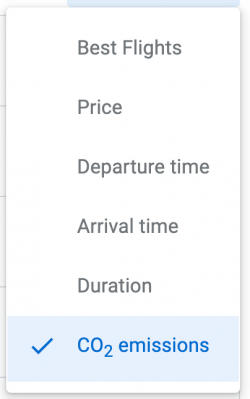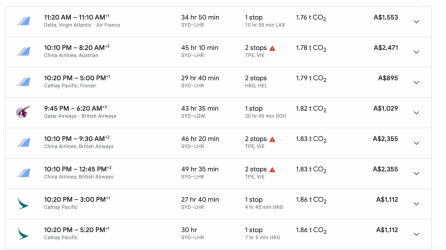henrus
Established Member
- Joined
- Jun 23, 2016
- Posts
- 4,305
- Qantas
- Platinum
- Virgin
- Platinum
I'm not sure how many people use google flights but a reasonably new addition is the emissions per flight. These now show on the specific flights once you drop it down:

Unlike the airline's own carbon emissions tools which appear to be based on distance, this new feature also takes into consideration the aircraft type, configuration, and cabin class. Obviously, these are just estimates but I still find it interesting and have been playing around quite a bit to find some interesting results.
Sydney to Canberra (in Economy), Qantas operates 4 types of aircraft (Dash 8-400, Dash 8-300, B717, and B737). Unsurprisingly the Dash 8-400 is most efficient with 37kg emissions, the 737 is 54kg, Q300 is 58kg, and the 717 is 64kg.
Sydney to Perth (in Economy). JQ's A320 is best at 333kg, followed by VA's 737 at 351kg, JQ's A321 at 368kg, QF's 737 at 369kg, QF's 787 at 421kg, and finally the QF's A330 at 503kg.
Finally, as Google flights allow for the sorting of flights by emissions you can also search long haul routes (including stops).

This is particularly interesting on a Sydney to London route. For a random oneway date in March 2022 the cheapest is $771 on British Airways. This option is however listed at 2.16t CO2. The most efficient is SYD-LAX (DL) and then LAX-LHR (VS) for $1553 likely due to the more dense configurations and use of A350s on the long haul flights coming in at 1.76t CO2.

For comparison QF1 (operated by a 787) is 2.03t CO2, EK's A380 option is 2.65t CO2 and one of the worst one-stop option is Singapore Airlines 777's at 3.14t CO2. Obviously, all of these are in Economy class... things are much worse in the premium cabin department ranging from 2.87t CO2 up to 8.53t CO2.
I have a few questions such as are these numbers accurate (I know nothing about aircraft emissions so have no idea about the accuracy)?
Would you consider a flight/aircraft based on aircraft emissions?
and do you think something similar should be included on the airline's own website (like how QF now lists an aircraft's wifi/entertainment status at booking?

Unlike the airline's own carbon emissions tools which appear to be based on distance, this new feature also takes into consideration the aircraft type, configuration, and cabin class. Obviously, these are just estimates but I still find it interesting and have been playing around quite a bit to find some interesting results.
Sydney to Canberra (in Economy), Qantas operates 4 types of aircraft (Dash 8-400, Dash 8-300, B717, and B737). Unsurprisingly the Dash 8-400 is most efficient with 37kg emissions, the 737 is 54kg, Q300 is 58kg, and the 717 is 64kg.
Sydney to Perth (in Economy). JQ's A320 is best at 333kg, followed by VA's 737 at 351kg, JQ's A321 at 368kg, QF's 737 at 369kg, QF's 787 at 421kg, and finally the QF's A330 at 503kg.
Finally, as Google flights allow for the sorting of flights by emissions you can also search long haul routes (including stops).

This is particularly interesting on a Sydney to London route. For a random oneway date in March 2022 the cheapest is $771 on British Airways. This option is however listed at 2.16t CO2. The most efficient is SYD-LAX (DL) and then LAX-LHR (VS) for $1553 likely due to the more dense configurations and use of A350s on the long haul flights coming in at 1.76t CO2.

For comparison QF1 (operated by a 787) is 2.03t CO2, EK's A380 option is 2.65t CO2 and one of the worst one-stop option is Singapore Airlines 777's at 3.14t CO2. Obviously, all of these are in Economy class... things are much worse in the premium cabin department ranging from 2.87t CO2 up to 8.53t CO2.
I have a few questions such as are these numbers accurate (I know nothing about aircraft emissions so have no idea about the accuracy)?
Would you consider a flight/aircraft based on aircraft emissions?
and do you think something similar should be included on the airline's own website (like how QF now lists an aircraft's wifi/entertainment status at booking?

















